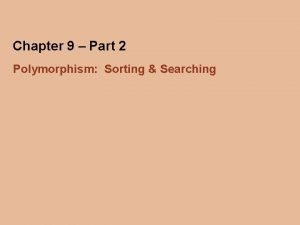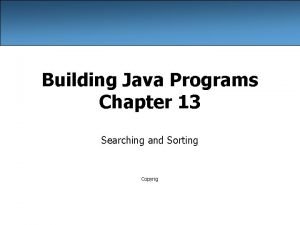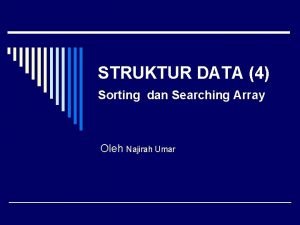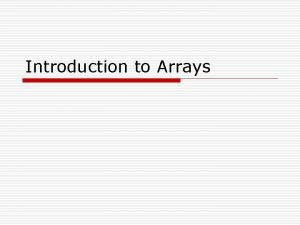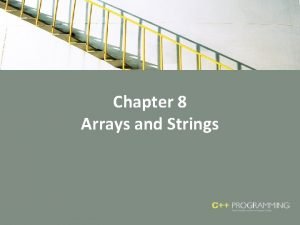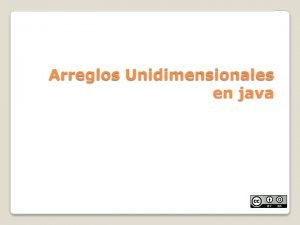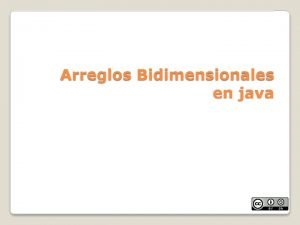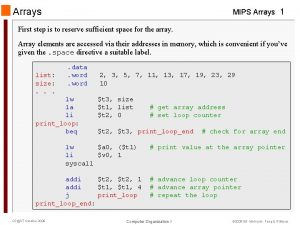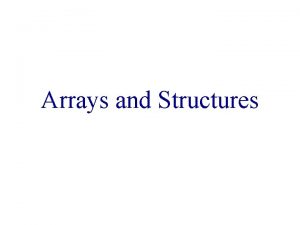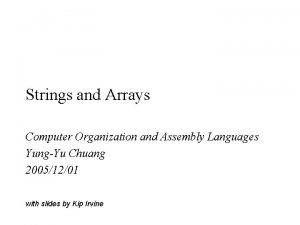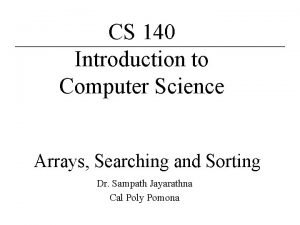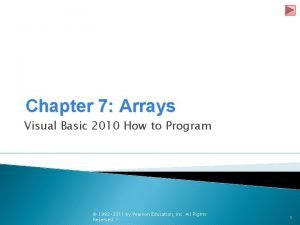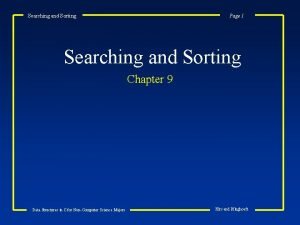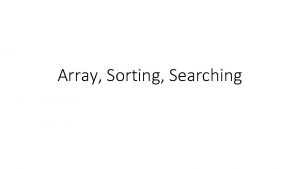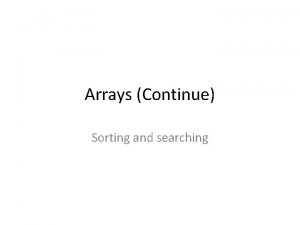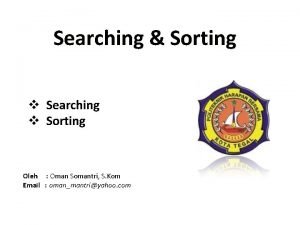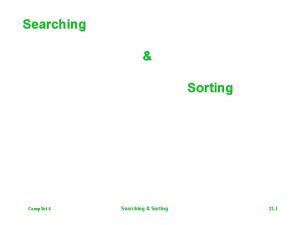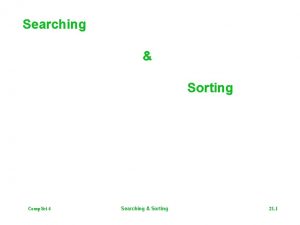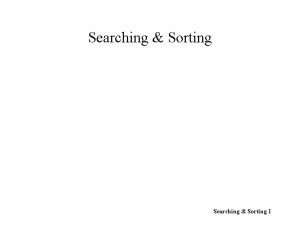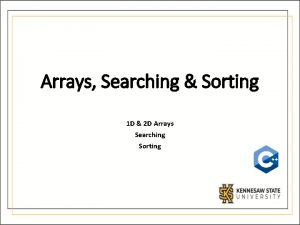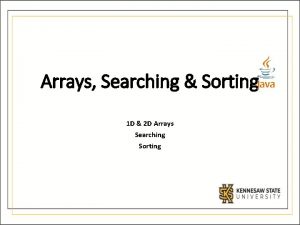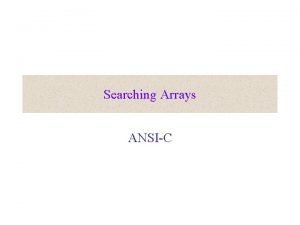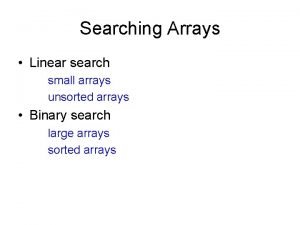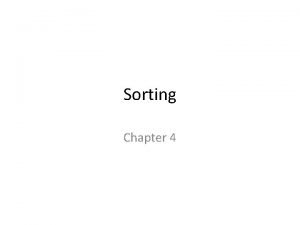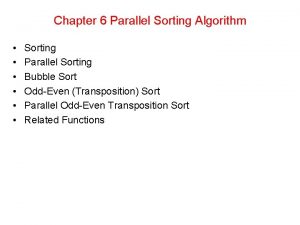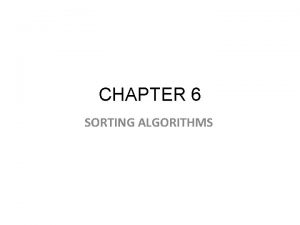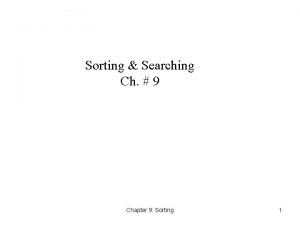Chapter 8 Searching and Sorting Arrays Csc 125














![Bubble Sort void sort(int array[], int elems) { bool swap; do { swap=false; for(int Bubble Sort void sort(int array[], int elems) { bool swap; do { swap=false; for(int](https://slidetodoc.com/presentation_image_h/acc47863fe860fde1108bdf14ccfa805/image-15.jpg)
![Bubble Sort ---- improved void sort(int array[], int elems) { for (int i = Bubble Sort ---- improved void sort(int array[], int elems) { for (int i =](https://slidetodoc.com/presentation_image_h/acc47863fe860fde1108bdf14ccfa805/image-16.jpg)




![Selection sort void sort 2(int array[], int elems) { int start. Scan, min. Index, Selection sort void sort 2(int array[], int elems) { int start. Scan, min. Index,](https://slidetodoc.com/presentation_image_h/acc47863fe860fde1108bdf14ccfa805/image-21.jpg)


- Slides: 23

Chapter 8 Searching and Sorting Arrays Csc 125 Introduction to C++ Fall 2005

Topics o o o Introduction to Search Algorithms Introduction to Sorting Algorithms Sorting and Searching Vectors

Introduction to Search Algorithms o o Search: locate an item in a list of information Two algorithms (methods): n n Linear search Binary search

Linear Search o Algorithm: set found to false; set position to – 1; set index to 0 while index < number of elts. and found is false if list[index] is equal to search value found = true position = index end if add 1 to index end while return position

Linear Search - Example o Array numlist contains: 17 o o 23 5 11 2 29 3 Searching for the value 11, linear search examines 17, 23, 5, and 11 Searching for the value 7, linear search examines 17, 23, 5, 11, 2, 29, and 3

Linear Search - Tradeoffs o Benefits: n n o Easy algorithm to understand Array can be in any order Disadvantages: n Inefficient (slow): for array of N elements, examines N/2 elements on average for value in array, N elements for value not in array

Binary Search 1. Requires array elements to be in order Divides the array into three sections: n n n 2. 3. middle elements on one side of the middle elements on the other side of the middle element If the middle element is the correct value, done. Otherwise, go to step 1. using only the half of the array that may contain the correct value. Continue steps 1. and 2. until either the value is found or there are no more elements to examine

Binary Search - Example o Array numlist 2 contains: 2 o o 3 5 11 17 23 29 Searching for the value 11, binary search examines 11 and stops Searching for the value 7, linear search examines 11, 3, 5, and stops

Binary Search - Tradeoffs o Benefits: n o Much more efficient than linear search. For array of N elements, performs at most log 2 N comparisons Disadvantages: n Requires that array elements be sorted

Introduction to Sorting Algorithms o Sort: arrange values into an order: n n n o Alphabetical Ascending numeric Descending numeric Two algorithms considered here: n n Bubble sort Selection sort

Bubble Sort Concept: n Compare 1 st two elements o n n n If out of order, exchange them to put in order Move down one element, compare 2 nd and 3 rd elements, exchange if necessary. Continue until end of array. Pass through array again, exchanging as necessary Repeat until pass made with no exchanges

Bubble Sort - Example Array numlist 3 contains: 17 23 5 11 compare values 17 and 23 – in correct order, so no exchange compare values 23 and 5 – not in correct order, so exchange them compare values 23 and 11 – not in correct order, so exchange them

Bubble Sort – Example (2) After first pass, array numlist 3 contains: 17 5 11 23 compare values 17 and 5 – not in correct order, so exchange them compare values 17 and 11 – not in correct order, so exchange them compare values 17 and 23 – in correct order, so no exchange

Bubble Sort – Example (3) After second pass, array numlist 3 contains: 5 11 17 23 compare values 5 and 11 – in correct order, so no exchange compare values 11 and 17 – in correct order, so no exchange compare values 17 and 23 – in correct order, so no exchange No exchanges, so array is in order
![Bubble Sort void sortint array int elems bool swap do swapfalse forint Bubble Sort void sort(int array[], int elems) { bool swap; do { swap=false; for(int](https://slidetodoc.com/presentation_image_h/acc47863fe860fde1108bdf14ccfa805/image-15.jpg)
Bubble Sort void sort(int array[], int elems) { bool swap; do { swap=false; for(int j = 0; j<(elems-1); j++) { if (array[j] > array[j+1]) { int T = array[j]; array[j] = array[j+1]; array[j+1] = T; swap = true; } } }while (swap); }
![Bubble Sort improved void sortint array int elems for int i Bubble Sort ---- improved void sort(int array[], int elems) { for (int i =](https://slidetodoc.com/presentation_image_h/acc47863fe860fde1108bdf14ccfa805/image-16.jpg)
Bubble Sort ---- improved void sort(int array[], int elems) { for (int i = (elems-1); i>=0; i--) { bool swap = false; for(int j = 0; j<i; j++) { if (array[j] > array[j+1]) { int T = array[j]; array[j] = array[j+1]; array[j+1] = T; swap = true; } } if (!swap) return; } }

Bubble Sort - Tradeoffs o Benefit: n o Easy to understand implement Disadvantage: n Inefficient: slow for large arrays

Selection Sort o Concept for sort in ascending order: n n n Locate smallest element in array. Exchange it with element in position 0 Locate next smallest element in array. Exchange it with element in position 1. Continue until all elements are arranged in order

Selection Sort - Example Array numlist contains: 11 1. 2 29 3 Smallest element is 2. Exchange 2 with element in 1 st position in array: 2 11 29 3

Selection Sort – Example (2) 2. Next smallest element is 3. Exchange 3 with element in 2 nd position in array: 2 3. 3 29 11 Next smallest element is 11. Exchange 11 with element in 3 rd position in array: 2 3 11 29
![Selection sort void sort 2int array int elems int start Scan min Index Selection sort void sort 2(int array[], int elems) { int start. Scan, min. Index,](https://slidetodoc.com/presentation_image_h/acc47863fe860fde1108bdf14ccfa805/image-21.jpg)
Selection sort void sort 2(int array[], int elems) { int start. Scan, min. Index, min. Value; for (int start. Scan = 0; start. Scan<(elems-1); start. Scan++) { min. Index=start. Scan; min. Value=array[start. Scan]; for(int j = start. Scan+1; j<elems; j++) { if (array[j] < min. Value) { min. Value = array[j]; min. Index=j; } } array[min. Index]=array[start. Scan]; array[start. Scan]=min. Value; } }

Selection Sort - Tradeoffs o Benefit: n o More efficient than Bubble Sort, since fewer exchanges Disadvantage: n May not be as easy as Bubble Sort to understand

Sorting and Searching Vectors o o Sorting and searching algorithms can be applied to vectors as well as arrays Need slight modifications to functions to use vector arguments: n vector <type> & used in prototype n No need to indicate vector size – functions can use size member function to calculate
 Searching and sorting arrays in c++
Searching and sorting arrays in c++ Big o java
Big o java Searching and sorting in java
Searching and sorting in java Searching and sorting in java
Searching and sorting in java Searching and sorting in java
Searching and sorting in java Internal and external sort
Internal and external sort Contoh searching
Contoh searching Pengertian searching dalam struktur data
Pengertian searching dalam struktur data Dynamic arrays and amortized analysis
Dynamic arrays and amortized analysis Advantages and disadvantages of arrays
Advantages and disadvantages of arrays Parallel arrays java
Parallel arrays java Array of arrays c++
Array of arrays c++ Ragged array
Ragged array Veteork
Veteork Parallel arrays
Parallel arrays Why do we need arrays?
Why do we need arrays? Vectores unidimensionales ejemplos
Vectores unidimensionales ejemplos Arreglos bidimensionales java
Arreglos bidimensionales java Arrays mips
Arrays mips Polynomial representation using array in c
Polynomial representation using array in c Array of strings assembly
Array of strings assembly Global arrays in c
Global arrays in c Computer science arrays
Computer science arrays Arrays visual basic
Arrays visual basic


